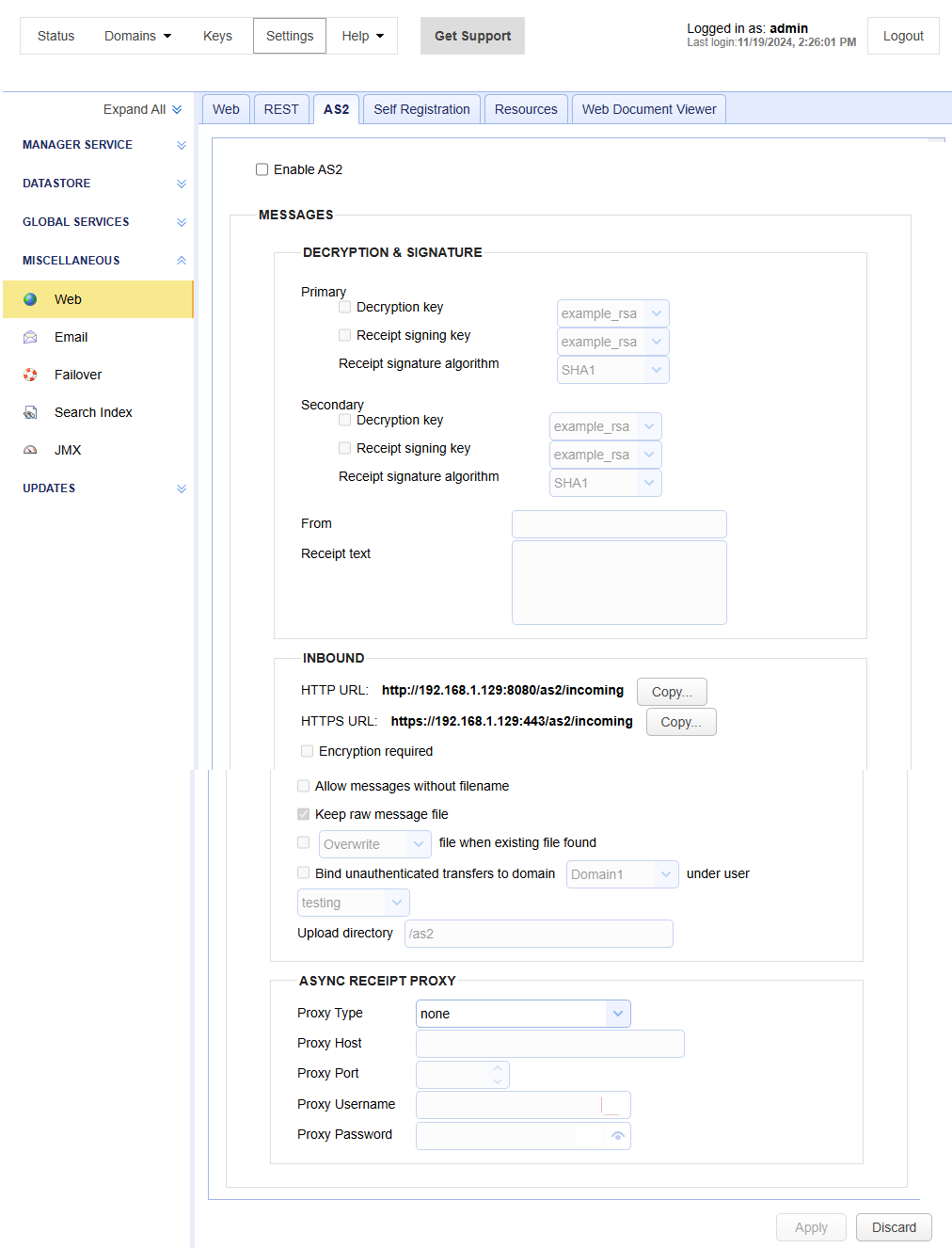Enabling AS2
Applicability Statement 2 (AS2) messages are sent over HTTP/S. To enable HTTP/S. See Enabling web based file transfers.
To enable AS2, navigate to Settings > MISCELLANEOUS > Web > AS2. The AS2 dialog displays.

The AS2 fields are described below.
Enable AS2 — Select this option to enable the receipt of AS2 messages.
DECRYPTION & SIGNATURE
Primary Decryption key — Identifies the private key used to decrypt AS2 messages encrypted using the corresponding public key. This key is sourced from
Keys > Server Keys.
Primary Receipt signing key — Identifies the private key used to sign MDN receipts in response to messages decrypted using the Primary Decryption key. This key is sourced from
Keys > Server Keys.
Primary Receipt signature algorithm — Identifies the message signing algorithm used when sending MDN receipts using the Primary Receipt signing key.
Secondary Decryption key — Identifies the private key used to decrypt AS2 messages encrypted using the corresponding public key. This key is sourced from
Keys > Server Keys.
Secondary Receipt signing key — Identifies the private key used to sign MDN receipts in response to messages decrypted using the Secondary Decryption key. This key is sourced from
Keys > Server Keys.
Secondary Receipt signature algorithm — Identifies the message signing algorithm used when sending MDN receipts using the Secondary receipt signing key.
From — Identifies the From header used when sending MDN receipts.
Receipt text — Identifies additional information to include in AS2 receipts.
INBOUND
HTTP URL — Identifies the HTTP URL that incoming AS2 partners connect to. This is a read-only field that is constructed using MFT Server's IP address and HTTP field values configured in
Settings > MISCELLANEOUS > Web > Web > WEB SERVER.
Note: If HTTP is disabled, you will see this message in the HTTP URL field:Disabled. Enable service in Settings -> Web. To enable HTTP, navigate toSettings > MISCELLANEOUS > Web > Web > WEB SERVERand selectHTTP on host.
HTTPS URL — Identifies the HTTPS URL that incoming AS2 partners connect to. This is a read-only field that is constructed using MFT Server's IP address and HTTPS field values configured in
Settings > MISCELLANEOUS > Web > Web > WEB SERVER.
Note: If HTTPS is disabled, you will see this message in the HTTPS URL field:Disabled. Enable service in Settings -> Web. To enable HTTPS, navigate toSettings > MISCELLANEOUS > Web > Web > WEB SERVERand selectHTTPS on host.
Encryption required — If selected, all incoming AS2 messages must be encrypted.
Signature required — If selected, all incoming AS2 messages must be signed.
Allow messages without filename — If selected, incoming AS2 messages may optionally have a filename attribute. If a filename attribute is not provided, a unique timestamp based on the filename is automatically generated. If not selected, AS2 messages must have a filename attribute.
Keep raw message file — If selected, AS2 messages are stored in their raw format under
var/as2/incomingandvar/as2/outgoingdirectories. This is useful for debugging purposes. Be careful not to let this directory grow unchecked as it may impact overall system performance.
[Overwrite | [Generate unique] file when existing file found — If selected, either an existing file is overwritten or a unique file is generated (see details below). If not selected, and the file already exists, the AS2 message is rejected.
Overwrite — If selected, and the file already exists with a matching filename attribute, the file is overwritten.
Generate unique — If selected, and the file already exists, the filename is rewritten as [originalfilename].[id] where id is the same ID used in the
var/as2/incomingfolder, and [originalfilename] is the original file name.
Bind unauthenticated transfers to [Domain] under user [User] — If selected, incoming AS2 messages that do not include user credentials are mapped to the specified Domain and User. If not selected, all incoming AS2 messages must include user credentials.
Upload directory — Identifies the directory relative to the user's root directory where AS2 message data is stored.
ASYNC RECEIPT PROXY
Proxy Type — Identifies the protocol configured for the proxy server. Protocols supported include HTTP, SOCKS4, and SOCKS5.
Proxy Host — Identifies the IP address or fully qualified domain name (FQDN) of the proxy server.
Proxy Port — Identifies the port the proxy server is using for transferring data.
Proxy Username — Identifies the username that has rights to access the proxy server.
Proxy Password — Identifies the username password.